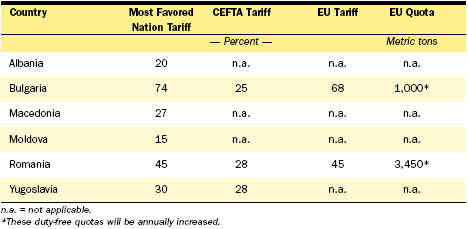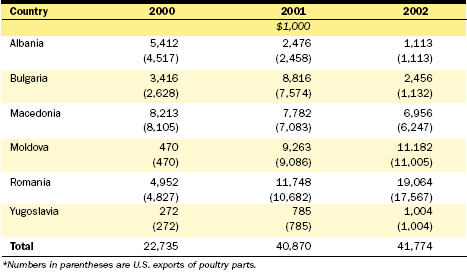



U.S. Poultry Popular in Balkans
US - The latest report from the USDA FAS shows that poultry exporters are making headway in consolidating and securing markets in the Balkans.
Popular broiler leg quarters account for 90 percent of U.S. exports, while chicken offal and turkey parts make up much of the remainder.
U.S. imports are taxed at the MFN (most favored nation) duty rate in Bulgaria, Romania, Moldova, Macedonia and Albania. Serbia does not currently allow any U.S. poultry products.
Country Specifics
Buying patterns vary among the countries and are important for exporters to consider. Extremes are common from year to year as recovery continues from the recent conflict in Kosovo and as new trading regimes become effective:- Serbia, unlike Yugoslavia’s other regions, Kosovo and Montenegro, does not import U.S. poultry meat due to veterinary sanitary limitations.
- Macedonia recently concluded WTO (World Trade Organization) accession negotiations and is expected to start implementing its commitments, which means poultry will have a 22-27 percent tariff with no TRQs (tariff-rate quotas).
- For 2002, Moldova reduced its tariff on chicken to a maximum 15 percent.
- EU (European Union) candidates Bulgaria and Romania grant preferences to poultry imports from EU member countries. Moreover, Bulgaria U.S. and Romania grant their CEFTA (Central European Free Trade Agreement) partners lower duties and preferential quotas.
- Albania permits U.S. poultry at a 20- percent tariff rate.
There are three major ports of entry for imported poultry in the region: Rotterdam in the Netherlands; Thessaloniki, Greece; and Constanza, Romania.
Thessaloniki mainly supplies Bulgaria, Yugoslavia, Albania and Macedonia.
From Constanza, frozen poultry parts and offal are distributed to major urban areas in Romania and Moldova for retail sales and processing. New cold storage facilities set up in Constanza and Tulcea, Romania, support this distribution, with more facilities expected to be operational
shortly.
Smaller amounts are transshipped by truck from Rotterdam to the region,
especially Yugoslavia.
| Applied Duty Rates on Imported Frozen Chicken Parts in 2002 |

|
"Backyard Production" Still a Factor
Structural reform measures and regional hostilities in the 1990s hurt local commercial production, particularly in Romania and Bulgaria, the region’s largest countries. However, these two EU candidates have received pre-accession funding to help them restructure their domestic industries.A large share of domestically produced poultry meat in the Balkans now comes from individual households. The commercial production that does exist, mostly in Serbia and Romania, is oriented mainly toward domestic consumers.
Few commercial plants are approved to export to Western markets. Consequently, the special access offered by the EU to Bulgaria and Romania is underutilized. Yugoslavia does, however, sell some poultry products to Bosnia and Herzegovina.
Though commercial poultry production is improving, it is still inefficient by global standards. The domestic producer groups that do exist tend to lobby for more protectionist regimes. Adopting EU practices will require poultry producers and processing plants to upgrade their plants, food quality and safety regimes, and also to improve their animal welfare and environmental standards.
Certificates Usually Required
Most Balkan countries have similar inspection certificate requirements, but there are also market specifics to keep in mind. Until Romania and Bulgaria become EU members, U.S. poultry products, chilled and frozen, can be exported under negotiated health certificates.The Yugoslav Veterinary Service currently does not accept USDA’s Food Safety and Inspection Service veterinary export certificate. Montenegro has no joint health certificate with the United States, but allows poultry imports. Local authorities in Kosovo accept U.S. poultry certificates, as do Albania, Macedonia and Moldova.
Labeling and Packaging
Broiler leg quarters are mostly shipped in bulk. Romania, however, recently adopted regulations changing the way poultry products can be shipped—poultry cuts cannot be wholesaled or retailed in bulk. Consequently, most imports arrive layer-packed and are repacked for retail, without defrosting, by domestic distributors.All products exported to the Balkans must be labeled in the destination country’s official language and English. Basic information to be included:
- Product name
- Names and addresses of exporter and importer
- Production and expiration dates
- Net weight in metric
- Storage recommendation
Rising Incomes Change Preferences
Consumption patterns are changing as incomes increase. Bulgarians now consume more poultry than their neighbors, at the annual per capita rate of 15 kilos (1 kilogram = 2.2046 pounds), followed by Romania with 12 kilos.Some preferences for white chilled meat attractively packaged and labeled are also surfacing. An interesting factor— there is not much retail price difference between chicken leg quarters and breast meat.
Demand for low-priced products like frozen whole birds or leg quarters remains high in the region, and U.S. poultry continues to be very competitive, especially with the lower prices seen in 2002.
| U.S. Frozen Poultry Meat Exports to Balkans* |

|
Source: Ag Exporter, USDA Foreign Agricultural Service - September 2003
By Cristina Cionga, Agricultural Specialist with the FAS Office of Agricultural Affairs in Bucharest, Romania








